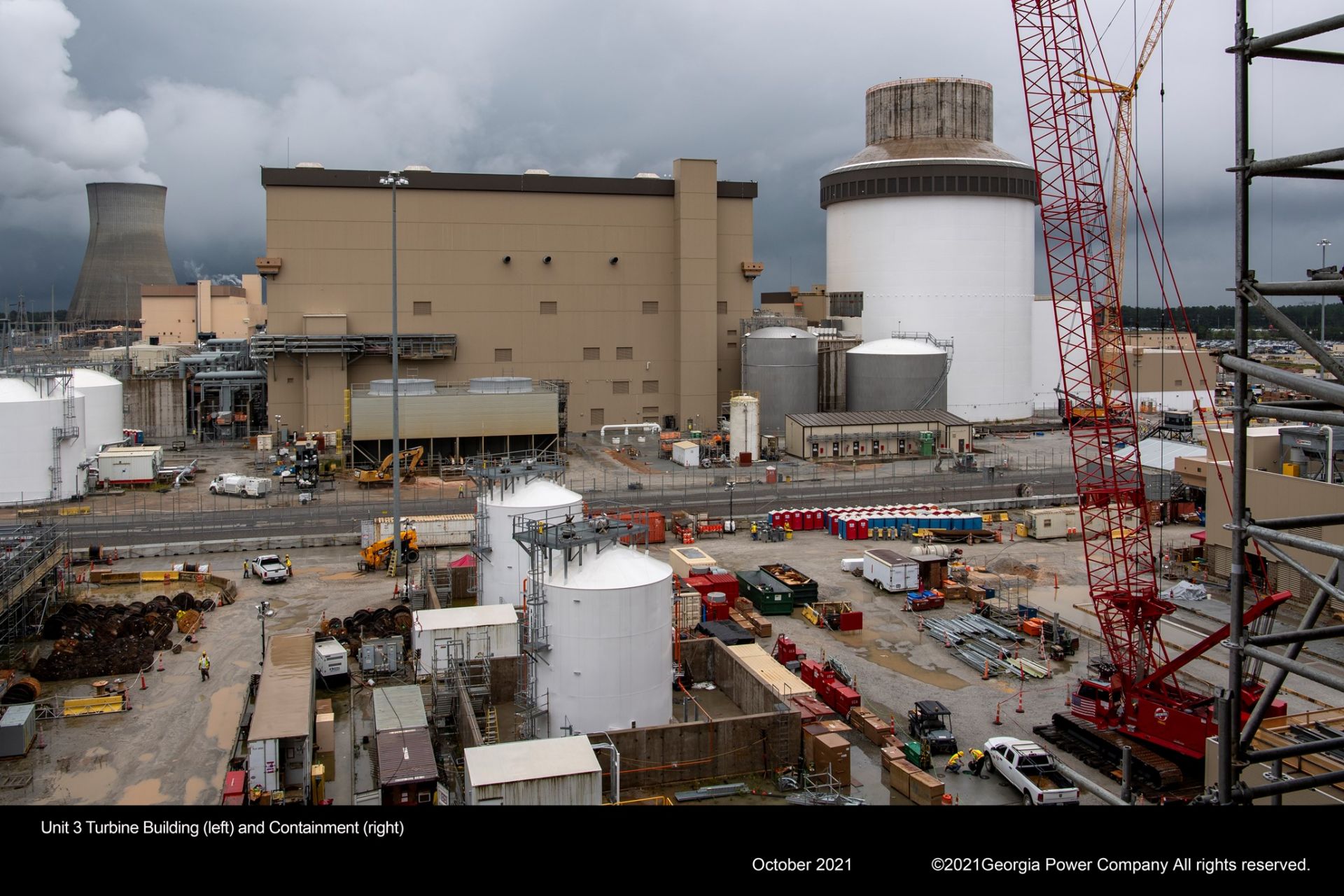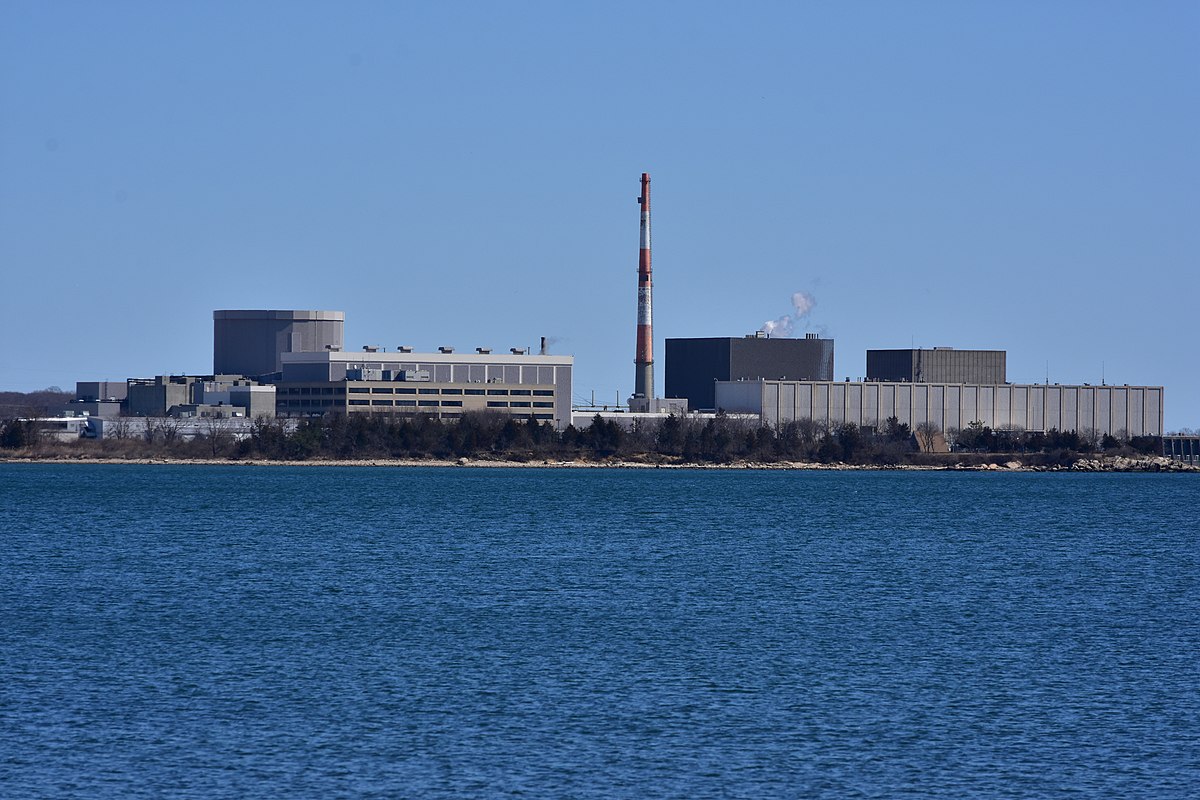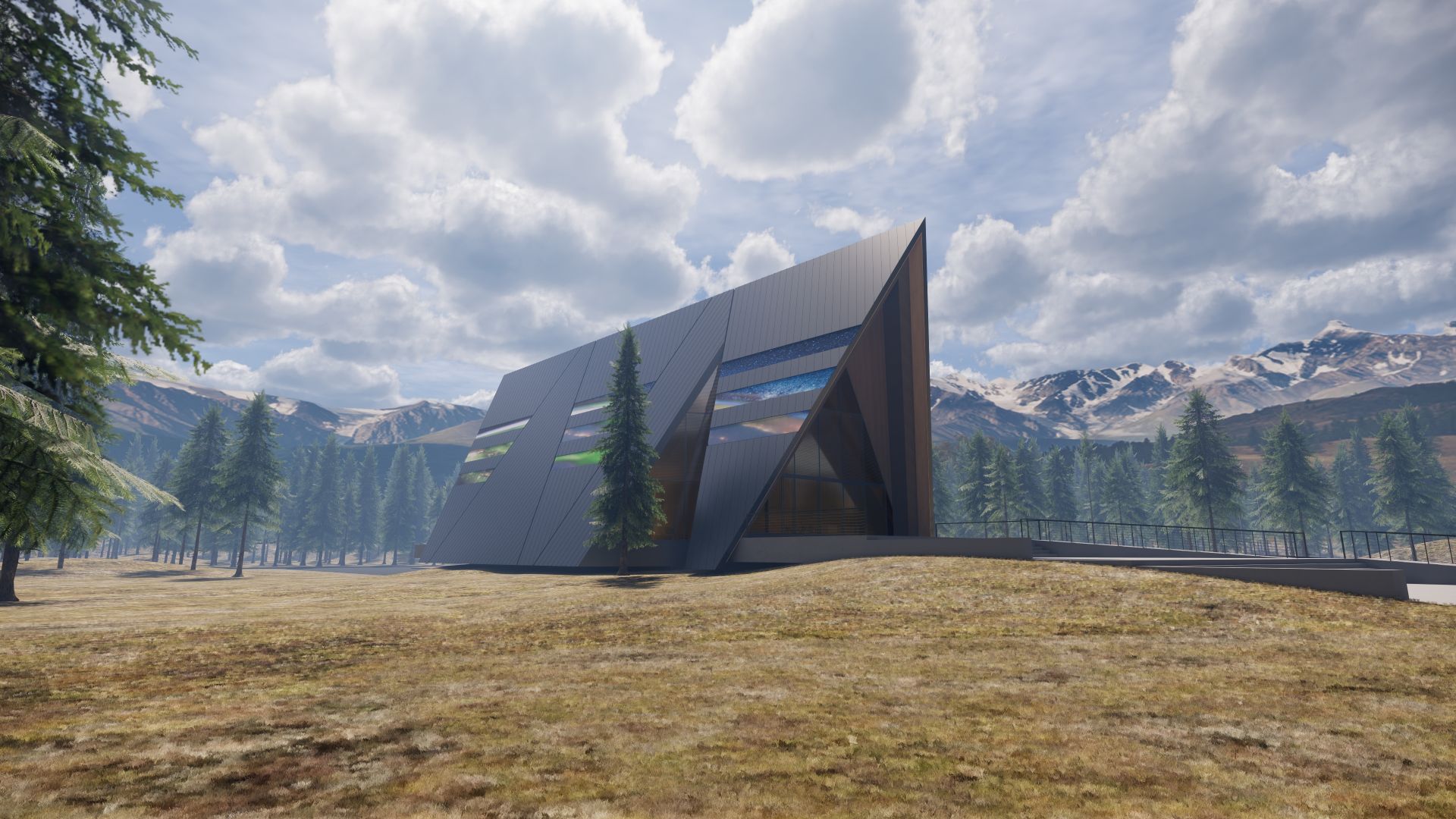The Vogtle-3 turbine building (left) and containment (right) in October. (Photo: Georgia Power)
The Nuclear Regulatory Commission will increase its oversight of Vogtle-3—one of the two Westinghouse AP1000 reactors under construction at the Vogtle nuclear power plant in Waynesboro, Ga.—after finalizing two inspection findings involving the unit’s safety-related electrical cable raceway system. Vogtle’s operator, Southern Nuclear, was informed of the decision in a November 17 letter.
The agency had launched a special inspection at Vogtle-3 in June of this year to determine the cause and extent of construction quality issues in the raceway system, which consists primarily of conduits and cable trays designed to prevent a single event from disabling redundant safety-related equipment.
SwRI engineers used LIDAR point cloud data to reconstruct a high-resolution image of a facility that houses electric turbines at the nuclear power plant. 3D cubes, or voxels, on the left provide spatial information on the turbine facility. Point clouds were reconstructed to create the high-resolution image of the turbines on the right. SwRI specializes in data visualizations to identify damage and potential hazards following accidents at nuclear power plants and other hazardous facilities. (Graphic: SwRI)
During the EnRicH 2021 European Robotics Hackathon, Southwest Research Institute’s unmanned aircraft system (UAS or drone) explored and mapped the interior of a nuclear power plant, detecting radiation sources autonomously, without the aid of a human pilot.
SwRI’s UAS technology can potentially assist in life-saving search-and-rescue missions and hazardous inspections at industrial facilities and infrastructure following natural disasters and other incidents.
Millstone nuclear power plant
The Nuclear Regulatory Commission has granted Dominion Energy’s request for an increase in the generating capacity of Millstone-3. The Richmond, Va.–based utility had applied for the power uprate last November, requesting an increase of approximately 1.6 percent.
NRC staff determined that Dominion could safely increase the reactor’s heat output, primarily through more accurate means of measuring feedwater flow, according to a November 18 press release. The NRC’s safety evaluation focused on several areas, including the nuclear steam supply systems, instrumentation and control systems, electrical systems, accident evaluations, radiological consequences, fire protection, operations and training, testing, and technical specification changes.
Artist’s concept of a fission surface power system on Mars. (Image: NASA)
NASA and Idaho National Laboratory have just opened a competitive solicitation for U.S. nuclear and space industry leaders to develop innovative technologies for a fission surface power system that could be deployed on the surface of the moon by the end of the decade. Battelle Energy Alliance, the managing and operating contractor for INL, issued a request for proposals and announced the news on November 19. Proposals are due February 17.
Westinghouse president and CEO Patrick Fragman and Energoatom president Petro Kotin sign a contract for the first AP1000 in Ukraine. They are joined by U.S. charge d’affaires to Ukraine Kristina Kvien and Ukraine energy minister Herman Halushchenko. (Photo: Westinghouse)
Westinghouse Electric Company and Energoatom, Ukraine’s state-owned nuclear utility, signed a contract in Kyiv yesterday outlining the details of an agreement to bring the Westinghouse AP1000 reactor to Ukraine’s Khmelnitsky nuclear power plant.
According to a Westinghouse press release, the contract initiates engineering and procurement of long-lead items for the reactor.
Signing the contract were Patrick Fragman, president and chief executive officer of Westinghouse, and Petro Kotin, Energoatom’s acting president. U.S. charge d’affaires to Ukraine, Kristina Kvien, and Ukraine energy minister Herman Halushchenko also attended the event.
[CLICK IMAGE TO ENLARGE] A comparison between MOOSE results and the analytical solutions for the fractions of point defects in an irradiated spherical Ni grain with a 500 nm radius. The grain boundary/surface at x = 500 nm is assumed perfect and neutral. (Source: From Frontiers in Materials paper "Surface and Size Effects on the Behaviors of Point Defects in Irradiated Crystalline Solids")
By using a combination of physics-based modeling and advanced simulations, Texas A&M University researchers say they have found the key underlying factors that cause radiation damage to nuclear reactors, which could provide insight into designing more radiation-tolerant, high-performance materials.
Artist’s conception of Oklo’s Aurora powerhouse. (Image: Gensler)
A set of graphite rods was exposed to hot plasma in the DIII-D tokamak. Researchers measured the ablation behavior under extreme heat and particle flow to simulate conditions experienced by spacecraft heat shields during atmospheric entry. (Image: General Atomics)
As a spacecraft on a research mission hurtles at up to 100,000 miles per hour toward the surface of a gas giant like Jupiter, the atmospheric gases surrounding the spacecraft turn to plasma, and spacecraft temperatures increase to more than 10,000 °F.
The Karachi nuclear plant in southern Pakistan. (Photo: CNNC)
Hot functional testing at Unit 3 of Pakistan’s Karachi nuclear power plant has been completed ahead of schedule, and the reactor has entered the fuel loading stage, China National Nuclear Corporation announced on November 11.
(CLICK IMAGE TO ENLARGE) The researchers’ experimental layout is depicted here. In (b), the neutron chopper is depicted without the mesh guard shown in (d), a photograph of the experimental layout that includes the Cf-252 source tank at left. (Composite image: Joyce, et al., “Wireless information transfer with fast neutrons,” doi.org/10.1016/j.nima.2021.165946)
Swapping conventional electromagnetic radiation for fast neutrons, a team of research engineers at Lancaster University in the United Kingdom, working with the Jozef Stefan Institute of Slovenia, report that they have successfully transmitted digital information wirelessly using nuclear radiation. The researchers’ attempts to transmit words and numbers using standard ASCII code “were 100 percent successful,” according to a November 10 press release from Lancaster University. Their research will be published in an upcoming issue of Nuclear Instruments and Methods in Physics Research and is now available online.
Darlington nuclear power plant. (Photo: OPG)
The Canadian Nuclear Safety Commission (CNSC) has amended Ontario Power Generation’s (OPG) operating license for its Darlington nuclear power station near Clarington, Ontario, allowing the company to produce the medical radioisotope molybdenum-99 using Darlington’s Unit 2 CANDU reactor. OPG subsidiary Laurentis Energy Partners, in conjunction with BWXT Medical, is leading the program to produce Mo-99 at Darlington.
 and containment (right).jpg)
















